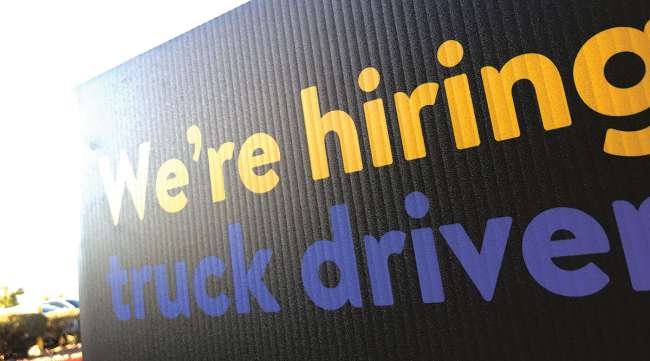Staff Reporter
Driver Recruitment Rolls On Amid 2023 Freight Downturn

[Stay on top of transportation news: Get TTNews in your inbox.]
The demand for professional truck drivers continued to show signs of activity this year despite an overall slowdown in the freight market.
The coronavirus pandemic brought with it a significant surge in freight demand that resulted in a heightened need for truck drivers. Many carriers took on this challenge by competing for drivers with improvements in pay, benefits and working conditions. But while the focus on recruitment and retention has waned somewhat this year, there are still opportunities out there for drivers.
“You can’t talk about anything in the trucking industry this year without mentioning the freight recession,” said Scott Dismuke, vice president of operations at the employee retention and analytics firm Professional Driver Agency. “I think it’s impacted everybody from the C-suite down to the driver, across the board, from just the freight and the rates, but also to recruiting and retention.”
The Fall 2023 Driver Survey, released by PDA and the driver recruitment advertising firm Conversion Interactive Agency, found the top two concerns drivers had were meeting monthly bills (72.4% of respondents) and time to be home with family (59.5%). It also noted 36.4% expressed the need for carriers to increase pay to attract and retain drivers, while 23.3% recommended guaranteeing a minimum for pay, mileage or loads.

“The freight market has certainly impacted the way that we’ve recruited this year,” said Priscilla Peters, chief marketing officer at Conversion Interactive Agency. “We’ve seen a lot of people really focus on, what we call the top of the driver funnel-type of recruiting strategies, to build brand preference with more passive drivers who may not be looking today, but we know will be looking in the future.”
Peters added that carriers know there will be a time when the freight market strengthens again even if they aren’t aggressively hiring drivers now. But there has still been signs of carriers this year tackling these economic challenges by reducing spending across their operations. Dismuke has seen that affect how much focus is being spent on both recruiting and retention.

Peters
“When drivers aren’t driving and logging as many miles, it still affects their ability to make what they’re expecting or what they’re hoping to make,” Dismuke said. “I think what we have seen this year from a pay standpoint is, while pay rates are up, miles are down. When miles are down, the pay rate doesn’t matter as much because it’s still affecting what that overall check looks like. And so I think that’s been the challenge, particularly from the carrier side of things.”
Dismuke stressed the importance of carriers continuing to invest in driver retention even when the freight market is slow. He noted the freight market will turn around eventually, and it can cost a lot more to find a new driver than it does to keep a current one.

Dismuke
“The freight rates peaked in ’21 — recruiting was crazy trying to get truck drivers to work and to fill the trucks through the first part of COVID,” said Mark Schedler, senior editor at the safety and regulatory compliance services company J. J. Keller & Associates. “But in ’22, rates had been sliding, volumes had been sliding. In ’23, it’s continued. So the demand for drivers has certainly gone down.”
Schedler also has seen carriers being able to acquire more used trucks this year with the spot market souring. He pointed out the spot market saw a surge in drivers when freight rates and demand were both high. But that changed when the market slowed, leaving many of these drivers with a lease and vehicle during a period of falling rates.
“XPO achieved a new record for full-time driver hires in Q4 this year,” said Carolyn Roach, chief human resources officers at the company. “Although recruiting drivers in some geographical areas remains challenging, we’ve seen the labor market loosening and the positive impact it’s had on the availability of more drivers to join our team. Our in-house driver school also plays a pivotal role in meeting the ongoing demand for skilled drivers.”
XPO also has reassessed how it uses sign-on and retention bonuses with the increased demand in applications per requisition. These incentives are now mainly considered for very critical and hard-to-fill roles, which marks a shift from how they were leveraged during and after the pandemic. The company ranks No. 5 on the Transport Topics Top 100 list of the largest for-hire carriers in North America.

“This year, we’ve also stayed agile and have adjusted our roles when business priorities shift,” Roach said. “For instance, with the recent launch of our new over-the-road operation, we shifted some of our driver recruitment priorities to attract hundreds of longhaul team drivers. In adapting our recruitment approach, we’ve tapped into new talent pools in new markets, giving us access to new skill sets that’ll make this operation successful.”
The Fall 2023 Driver Survey also recorded the lowest number of drivers ever that were looking for a new job at 33.3%. That compared to the year-ago period of 40.2%. But this may not be completely because of job satisfaction, with the survey finding that of those who weren’t looking for a new job, 13.9% said they were afraid to make a move in the current economy, with an additional 15.6% saying they needed more experience. But for those looking, 62.8% said they wanted more predictable pay.
“Those of us who’ve been here awhile, old-timers, if you will, we know how cyclical the economy of trucking is,” Peters said. “And so it’s been interesting from a retention standpoint. Fleets are really having to look at and focus on, how do I communicate with my drivers that, yes, you might be getting less miles, but that you’re going to be getting that most places you go because of the way freight is today.”

Some drivers who aren't looking for a new job say they need more experience first. (Hispanolistic/Getty Images)
The MG Truck Driving School in Glendale, Ariz., opened up amid the freight market downturn Sept. 5. But the school still has seen interest from people wanting to be drivers and carriers wanting to hire them. The school even reports that 98% of the students who have graduated so far have been hired.
“It seems like every company is hiring,” said Russell Hoyt, the school’s director. “You hear about the downturned economy and it’s a reality. Freight is down; fuel is up. Owner-operators, unfortunately, are taking a good run of that, the smaller companies are. But I think it’s cyclical in nature. Yes, there are extenuating circumstances as to why the economy is doing what it’s doing, but the fact is it’s a healthy part of economies and just the way it works.”

Schedler
Schedler stressed the importance of recruiting on social media to find drivers. He noted this is especially true when it comes to younger drivers. He also noted that having a presence on social media is still important even when a carrier is not actively recruiting because it can be difficult to get the recruitment process up and running again.
“When I was doing it there wasn’t social media as much as it was all the other outlets,” Schedler said. “But now you still have to keep a presence on social media. You’ve got to keep your name out there. Drivers want to know, if they aren’t happy with their current carrier, the next-best carrier needs to be top of mind. Anytime we slowed things down, it was God awful to try and start priming the pump again. So it’s a kind of a conundrum.”
Schedler also discussed the importance of carriers focusing on driver health. He has seen from government statistics and industry feedback that blood pressure, sleep apnea and diabetes have become major medical issues among drivers. He noted that carriers are struggling with recertifications and keeping drivers on the road as a result.
In this special year-in-review episode, we delve into the journey and future of alternative fuel trucks. How are they paving the way for a greener 2024? Tune in above or by going to RoadSigns.ttnews.com.
“When we talk and when companies talk recruiting, the number that you hear about a lot is, what is the cost for hire,” Dismuke said. “But I think one of the things that we really should be talking about is what is a cost per loss. So what does it cost the company to lose a driver? And that cost per hire is only a fraction of that.”
Dismuke noted there are other things that go into how much it costs a company to lose a driver, such as reduced production and efficiency. He has also seen issues with equipment wear, the possibility of increased insurance premiums and customer relationships being impacted. He noted this can all lead to lost revenue opportunities.
“We’re committed to retaining and supporting our 22,000 team members for their success at work and in life,” Roach said. “Our data shows that the longer drivers stay with us, the safer they are on the roads, the better they take care of our customers and the more skilled they become. Frontline managers are crucial for retention in this business, and this year, we’ve been dedicated to investing in their development so they can lead our driver workforce more holistically.”
Want more news? Listen to today's daily briefing below or go here for more info:





